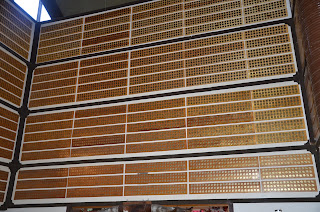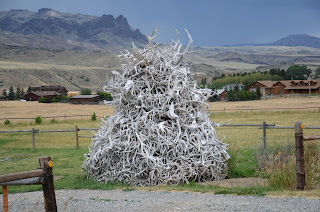After Wednesday's challenging weather I was ready for any improvement although I cannot complain about the conditions I have experienced. Hot and humid are not really terrible words to a motorcyclist, especially when the alternatives can be rain, hail, lightning, freezing cold, or fog. On Thursday morning there wasn't a cloud in the sky, but at Missoula's approximately 3200 foot altitude at 7:00 a.m. that is not necessarily a good thing. I was on the road at about 7:30 hoping to make up some of the distance that I hadn't done the day before. The temperature was decidedly 'nipply' but, hey, it's the middle of August. How bad could it be? About 20 miles into the ride my fingers were feeling a bit tingly and 30 minutes in they were cold. I had only about 20 miles to go to reach the $50 000 Bar and a hot coffee, and while I had my heated gloves readily available, the wiring harness was in one of my saddlebags and I didn't want to stop to dig them out and have to repack so I pushed on. I arrived at the Bar about 20 minutes later after about 50 miles of cold riding.
When I mentioned to the lady at the cash register that it seemed a bit cool this morning, she informed me that the overnight temperature was 34 degrees F., and that it was now 37 degrees. I was grateful for the hot coffee. I spoke to a rider from eastern Washington who had ridden from Sturgis to Missoula the day before - a distance of 750 miles - in the uncertain weather. He said that it had been a long day but he needed to be home today so he pushed on. I noticed that he pulled a heavy sweatshirt out of his saddle bag and put it on under his jacket before he left.
This place has a bar with literally thousands of Morgan silver dollars embedded in the bar and in sheets of wood that are mounted on the walls. At last count there were more than 53 000 of these coins on display in the bar. Many, if not all of the coins, have the names of the people who placed them there. I noticed one that was put there by a couple from Wetaskiwin, Alberta in 1954, so the bar has quite a history. I can only imagine what it must have been like with the cars of the time, and in the days before the Interstate Highways, what it would have been like to get here.
Silver Dollars embedded in the bar.
More Morgan silver dollars on display on the barroom walls.
As well as being a cafe and bar, the place also sells souvenirs and Montana jewellery, so before I left I bought Darlene a silver bracelet with a gold-type inlay. By the time I was ready to leave, half an hour later, the sun had warmed up the air considerably so the ride wasn't at all chilly, except in those areas that were still in deep shadows.
This part of the ride was about 120 miles, or under two hours to Coeur d'Alene, Idaho and I made it in good time. Two things about the highways in this part of the US. The first is that there is a lot of new construction and upgrades happening with new bridges and road surfaces being laid down to replace the old, often very rough surfaces. The second is that instead of asphalt, many of the highways are made of concrete and the line where the pads join is often raised. You often find yourself riding along with the bike going kathump, kathump, kathump, for miles on end. The concrete is often much more uneven than asphalt as well so the ride isn't as smooth. Much of the ride in this section of the highway was two lanes at 65 mph.
The entrance to Coeur d'Alene from the east is along the river and lake of the same name. It is a beautiful way to enter this city. After stopping for gas I pushed on to Spokane, WA, where the 1974 World Exposition was held. Many of the names in the city reflect this. The two cities are only about 40 kilometres apart and with urban sprawl, there isn't a lot of open country between the two. Spokane is also a rail centre for the Burlington Northern Santa Fe (BNSF) railroad with trains regularly heading east and west. In the early 1900s with the explosion in railroad building, Spokane was the centre for the railways in the US that were trying to push into the rich mining country of southeastern BC. The smelter at Trail was orignally built as part of a railway company owned by a Spokane businessman, Augustus Heinze, and the Columbia and Western Railway which was bought by the CPR in 1898 along with the smelter was built by the same magnate.
This area of Washington State is called the Palouse, and is a fairly flat agricultural area with outcrops of volcanic rock that covered much of this area millions of years ago. The land is gently rolling farmland that grows hay, grain, and other crops. Some of the hay is gathered and placed in long high structures that look like old time military barracks covered with tarps. There are often eight or ten of these structures in one place and businesses sell hay tarps.
As I was in Spokane I saw a BNSF train moving west out of the yard. After stopping for a while at the Harley dealership I resumed my ride west. The railway parallels the highway for some distance and about fifty kilometres on I again saw this train, this time rolling along at a good clip, silhouetted against the horizon. It was a striking scene and a somewhat iconic western one.
This land is like much of the west, in that in certain areas you can see for a very long distance to the horizon. They aren't closed in like many people are in cities and in areas with forests. As I rode along there were several ploughed very large fields. The heat was causing 'dust devils' to form. These are like mini tornadoes that form on the ground and pick up dirt and other materials and make columns that can be seen for a long distance. At one point I counted eight of them in that large field.
Grain field in the Palouse, eastern Washington.
Grain field and ploughed area, the Palouse, eastern Washington
Just as on the Canadian prairies, it is very difficult to get a good cup of coffee, unless your idea of good coffe is Tim Horton's. The same holds true in this part of the US just as it does in Swift Current, Brandon, and other Canadian cities. Bozeman is a city with a population of just under 40 000 but it does not have a Starbucks outlet. For those of us on the west coast who are used to the ubiquitous presence of Starbucks coffee shops (Campbell River has two), their absence is a disappointment, if not a hardship. And yet, when I stopped in the tiny town of Ritzville which I had never heard of before, on the I-90 beside the Macdonald,s there was a Starbucks. That was my first clue that I was getting close to home!
The Columbia River bisects the state and there is a huge lake formed by the Wannapum Dam south of Vantage, WA. where I-90 crosses the Columbia. On the eastern side of the river there is a viewpoint where you can look down the lake and also see the layers of rock created by volcanic extrusions which occurred between 17 and 13 million years ago and that underly much of the state. It's a beautiful area and well worth stopping to see. From the viewpoint you can see for miles both north and south across the river and surrounding area. Across the river near Vantage there is a huge wind farm with more than 130 windmills slowly turning their blades creating electricity without burning fossil fuels or harnessing rivers. The wind blows regularly here and this accounts for the placement of the generators.
View to the north of the Columbia River/Reservoir
View to the south with the bridge over the Columbia.
Detail of the extruded rock in this part of Washington.
Big Red at the Columbia River
The riding had been great all day and continued to be so. I continued on through Ellensburg to the Snoqualmie Pass, which at slightly over 3000 feet would hardly qualify for that title farther east. The usual afternoon winds picked up and again I faced crosswinds in the open country before the pass. As I approached the pass the winds dropped but the inevitable road construction and the resulting single lane traffic slowed progress somewhat. The road has many twists and turns and at 65 mph it is an interesting ride. Some corners have signs advising drivers to slow to 50 mph. Despite all our modern machinery, topography still rules!
Despite their relatively low altitude, the Cascades are still quite striking. Many of the mountains still have snow on them at this late stage of the year.
Near Snoqualmie Pass
Snoqualmie Pass
Leaving the pass I entered the Seattle suburbs from the east. Traffic in Seattle is very heavy at any time of the day but I had arrived in rush hour. Fortunately, rather than having to fight traffic in Seattle, I was able to do so on the eastern side of Lake Washington. While I made between 30 and 40 mph much of the time, at other times traffic was stop and go until I finally merged with I-5 heading north, just south of Everett. Again traffic was heavy through Everett, but north of there the road opened up and I was able to make good time through Mount Vernon and on to Burlington. When I pulled in to the motel I had ridden about 950 kilometres, my longest day of the trip.
Thursday was a great riding day, despite the cold start and it put me a day earlier to getting home. It is only a 300 km run to Campbell River factoring in the border crossing and ferry ride to the Island. It's already starting to look like home and that feels good.


























































